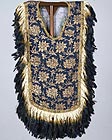Japanese Gallery (Honkan) Room 9
August 9, 2011 (Tue) - October 10, 2011 (Mon)
Bugaku, a performance art in which dance accompanies court music, was introduced to Japan from China and Korea during the Nara period (8th century). In the following Heian period (end of 8th – 12th century), bugaku developed to be performed at festivities within the court, although masks and costumes from this time no longer survive. From the medieval eras, bugaku was performed as dedications to the gods in shrine and temple rituals. Masks and costumes used during the Kamakura to the Muromachi period (end of 12th – late 16th century) have been passed down until today.
Of special note are the bugaku masks, costumes, and headdresses at Amano-sha Shrine, in Mount Koya, Wakayama, which was dedicated by the prominent Buddhist priest Kukai (Kobo Daishi). These are known to have been used in Buddhist services held for the Issai-kyo sutra, which continued from the Kamakura period. The costumes display distinctive designs and production methods of the medieval times, such as in the application of a design to the entire garment using stitch resist dyeing in indigo, or board clamp resist dyeing using boards with the design carved into them. One common technique in the Kamakura through the Muromachi period was printing designs from woodblock in black ink, which in the Edo period (17th – late 19th century) was replaced by embroidery for more sumptuous designs. Works from the medieval times display characteristic techniques in brocade and embroidery as well.
This exhibition features the medieval expressions of motifs in bugaku, which are distinctive from the present traditions that were stylized in the early modern era.

